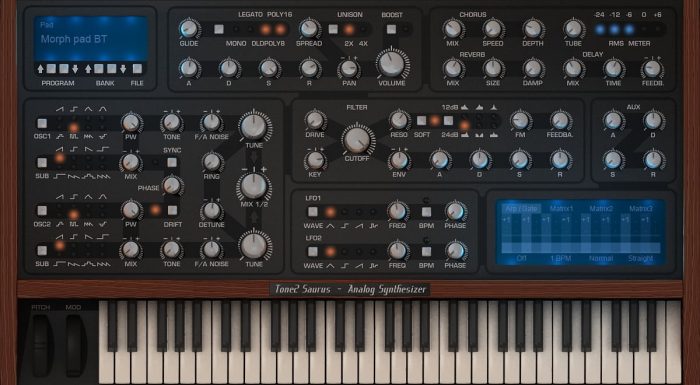In many ways there is a world of difference between hardware and software. Feel, size & weight, smell(?!), price… But as far as sound quality goes, virtual analog synthesizer plug-ins are increasingly becoming more like their hardware counterparts. I am not sure how developers got the sound of vintage synths in early emulations and “inspired by” synth plug-ins, but today it is all about modeling the originals down to the smallest parts.
Hot on the heels of FXpansion and u-he comes Tone2 with its Saurus virtual analog circuit-modeled synthesizer.
We carefully measured and modeled the circuits of many classic performance synthesizers, even including single capacitors and resistors to provide an extremely accurate analog model, faithfully capturing the spirit and character of these old machines.
Saurus aims to deliver that analog flavor with its “True Analog Modeling Technology”, which according to Tone2 gives the oscillators the warm characteristic sound of analog hardware.
The synth comes with a vintage look and a straightforward workflow.
The synth features two oscillators with 8 selectable waveforms each, including all the classic ones you would expect, plus some additional ones similar to Roland’s Alpha Juno (PWM Sawtooth & Comb) and an organ stack inspired by Farsivar analog organs. The PW control allows you to extend range of sounds even more by morphing osc waveforms into more shapes. Both oscillators are paired with sub oscillators, also with 8 selectable waveforms each.
Controls are available for mixing oscillators and subs, tone, frequency and amplitude modulation noise, ring modulation, sync of both oscs, tune & detune, a phase adjust, and of course drift to get some of that vintage unstable sound.
The filter section sports 6 filter types, including three Chamberlin modeled filters (12dB LP, HP, and BP), a 24dB LP Butterworth filter, a notch and a formant filter. The 12dB LP is said to have the character similar to Korg’s MS-20. I don’t know too much about filter topologies or how Chamberlin and Sallen-Key relate, but the filter sure does some nice screaming. Not quite as aggressive as its reference but it sounds great nonetheless, especially when dialing in some extra drive.
Saurus comes with 2 LFO’s, which only have 4 waveforms – I guess due to limited space on the interface – but you can select more waveforms from within the modulation matrix. The modulation system is kind of… vintage. No smart features here, just three pages of 5 modulation slots to assign sources and targets.
Interestingly enough, there are some parameters in the mod matrix that you can’t access anywhere else, e.g. white and pink noise modulation sources. The mod matrix is also the only place where you can make use of the ADSR envelope of the AUX section.
To increase control over the modulation, Tone2 has also implemented some modifiers which basically sit in between the mod source and destination.
Switching the Mod Matrix screen to the first tab opens up the arpeggiator/gate, which also serves as a modulation source. The arpeggiator includes some interesting features like chord and release steps, step velocity and swing.
Unlike previous Tone2 synthesizers, the effect section is quite limited. The chorus, reverb, and delay units have just 3 knobs each, and a one-knob tube effect adds some analog tube warmth to your sound.
The general section has controls for note glide, voice mode, unison (2-4x) with spread, a “psycho-acoustic boost”, ADSR envelope and pan & volume.
Saurus comes with no less than 563 presets by 20+ sound designers. The presets can be selected from the patch browser in the top left, where they are categorized by sound type.
Tone2 recently held a contest in which people were asked to create some tracks with a vintage character. Check out the winning entry below to get an idea of what Saurus can sound like.
Tone2 has posted a comprehensive introduction video for Saurus, so check it out below if you’d like some more details about this plugin.
So what do I think?
Format: VST/AU plug-in
Price: 99 EUR / $119 USD
Like: Simple design, easy to program, versatile
Don’t like: Some features are mod matrix only
Verdict: 8/10
There has been a lot of talk about Saurus, especially on forums like KVR where everything gets compared to bits.
The obvious challenge for Tone2 was to take on u-he’s Diva, but to be honest, in terms of sound quality Diva is just miles ahead of the competition. And that’s alright, because both are actually quite different. Whereas Diva’s semi-modular design excels in sound quality, Saurus is more like a simple vintage synthesizer in a modern outfit. Easy to program, relatively easy on the CPU, and surprisingly versatile.
Tone2 – or its marketing copy – was perhaps focusing a little too much on trying to highlight Saurus’ “True Analog” features, while Saurus in fact is a great all-round synth. Sure it does some lovely Alpha Juno type detuned saw sounds, but I really enjoyed browsing its presets and finding way more variety than I would expect from the average virtual analog.
In short, Saurus is a capable synthesizer in the area of both analog and digital type sounds. It is easy and fun to work with, and it has a fair price tag. Check out the demo and see what you think.
More information: Tone2 / Saurus




